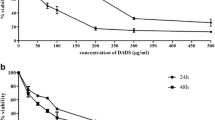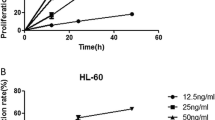Abstract
We investigated the effects of diallyl disulfide (DADS) on the induction of apoptosis in human Leukemia cell line HL-60 and explored the roles of mitogen-activated protein kinase (ERK and p38 MAPK) pathways in the growth inhibition and apoptosis induced by DADS. MTT assay was used to determine the DADS induced cell growth inhibition in HL-60 cells. Flow cytometry and DNA fragmentation were used to examine the roles of apoptosis in DADS-mediated cell death. Western blot analysis of the expression of phospho-MAPKs (ERK and p38) was employed to elucidate the possible mechanisms of DADS induced apoptosis. We found that growth inhibition of HL-60 cells treated with DADS exhibited a dose-dependent response (P<0.05) and DADS induced significant apoptosis. DADS at the concentration of 10 mg/L persistently activated p38 and simultaneously reduced ERK activity. PD98059, an inhibitor of ERK upstream activators MAPK kinase MKK1 and MKK2, promoted cytotoxicity and apoptosis in HL-60 cells treated with DADS. In contrast, SB203580, an inhibitor of p38, decreased cytotoxicity and apoptosis induced by DADS. Therefore, DADS can effectively inhibit the proliferation and induce apoptosis of human leukemia cell line HL-60. Inhibition of ERK signaling pathways and activation of p38 signaling pathways are likely involved in DADS induced apoptosis in HL-60 cells.
Similar content being viewed by others
Abbreviations
- DADS:
-
Diallyl disulfide
- MAPK:
-
mitogen-activated protein kinase
- ERK:
-
extracellular signal-regulated kinase
References
Adams J. M. and Cory S., Life-or-death decisions by the Bcl-2 protein family. Trends Biochem. Sci., 26, 61–66, (2001).
Berra, E., Diaz-Meco, M. T., and Moscatt, J., The activation of p38 and apoptosis by the inhibition of Erk is antagonized by the phosphoinositide 3-kinase/Akt pathway. J. Biol. Chem., 73, 10792–10797 (1998).
Bong-Jo. K., Seung-Wook, R., and Byoung-Joon, S., JNK-and p38 Kinase-mediated phosphorylation of bax leads to its activation and mitochondrial translocation and to apoptosis of human hepatoma HepG2 cells. J. Biol. Chem., 281, 21256–21265 (2006).
Domina, A. M., Smith, J. H., and Craig, R. W., Myeloid cell leukemia 1 is phosphorylated through two distinct pathways, one associated with extracellular signal-regulated kinase activation and the other with G2/M accumulation or protein phosphatase 1/2A inhibition. J. Biol. Chem., 275, 21688–21694 (2000).
Ewis, T. S., Shapiro, P. S., and Ahn, N. G., Signal transduction through MAP kinase cascades. Adv. Cancer Res., 74, 49–60 (1998).
Gao, R. T., Zheng, F. L., Li, X. M., Bo, Y. H., Liu, Y. X., Zheng, D. X., and Liu, Y., Aristolochic acid I-induced apoptosis in LLCPK1cells and amelioration of the apoptotic damage by calcium antagonist. Chinese Medical Journal, 113, 418–424, (2000).
Knowles, L. M. and Milner, J. A., Possible mechanism by which allyl sulfides suppress neoplastic cell proliferation. J. Nutr., 131, 1061–1066, (2001).
Kwon, K. B., Yoo, S. J., Ryu, D. G., Yang, J. Y., Rho, H. W., Kim, J. S., Park, J. W., Kim, H. R., and Park, B. H., Induction of apoptosis by diallyl disulfide through activation of caspase-3 in human leukemia HL-60 cells. Biochem. Pharmacol., 63, 41–47 (2002).
Kumar, P., Coltas, I. K., Kumar, B., Chepeha, D. B., Bradford, C. R., and Polverini, P. J., Bcl-2 protects endothelial cells against gamma-radiation via a Raf-MEK-ERK-survivin signaling pathway that is independent of cytochrome c release. Cancer Res., 67, 1193–1202 (2002).
Lan, H. and Lu, Y. Y., Allitridi induces apoptosis by affecting Bcl-2 expression and caspase-3 activity in human gastric cells. Acta Pharmacol. Sin., 25, 219–225 (2004).
Lu, H. F., Sue, C. C., Yu, C. S., Chen, S. C., Chen, G. W., and Chung, J. G., Diallyl disulfide (DADS) induced apoptosis undergo caspase-3 activity in human bladder cancer T24 cells. Food Chem. Toxicol., 42, 1543–1552 (2004).
Lewis, T. S., Shapiro, P. S., and Ahn, N. G., Signal transduction through MAP kinase cascades. Adv. Cancer Res., 74, 49–60 (1998).
Milella, M., Estrov, Z., Kornblau, S. M., Carter, B. Z., Konopleva, M., Tari, A., Schober, W. D., Harris, D., Leysath, C. E., Lopez-Berestein, G., Huang, Z., and Andreeff, M., Synergistic induction of apoptosis by simultaneous disruption of the Bcl-2 and MEK/MAPK pathways in acute myelogenous leukemia. Blood, 99, 3461–3464 (2002).
Milner, J. A., A historical perspective on garlic and cancer. J. Nutr., 131, 1027–1031 (2001).
Nakagawa, H., Tsuta, K., Kiuchi, K., Senzaki, H., Tanaka, K., Hioki, K., and Tsubura, A., Growth inhibitory effects of diallyl disulfide on human breast cancer cell lines. Carcinogenesis, 22, 891–897 (2001).
Park, E. K., Kwon, K. B., Park, K. I., Park, B. H., and Jhee, E. C. I., Role of Ca2+ in diallyl disulfide-induced apoptotic cell death of HCT-15 cells. Exp. Mol. Med., 34, 250–257 (2002).
Xiao, D., Pinto, J. T., Gundersen, G. G., and Weinstein, I. B., Effects of a series of organosulfur compounds on mitotic arrest and induction of apoptosis in colon cancer cells. Mol. Cancer Ther., 4, 1388–1398 (2005).
Wu, M. H., Huang, W. G., Tan, H., He, J., and Su, Q., Induction of differentiation by diallyl disulfide through inhibition of JAK1/ STAT3 in human leukemia HL-60 cells. Chin. Pharmacol. Bull, 21, 580–583 (2005).
Wu, M. H., Su, Q., Cheng, A. L., Tan, H., and Song, Y., Experimental study of HL-60 cell differentiation induced by diallyl disulfide. Chin. Pharmacol. Bull, 19, 319–322 (2003).
Wu, M. H., Tang, L., Li, L. P., Huang, W. G., and Su, Q., Effect of growth inhibition and differentiation of HL-60 cell induced by diallyl disulfide. Zhonghua Xue Ye Xue Za Zhi, 25, 300–302 (2004).
Wu, X. J., Kassie, F., and Mersch-Sundermann, V., The role of reactive oxygen species (ROS) production on diallyl disulfide (DADS) induced apoptosis and cell cycle arrest in human A549 lung carcinoma cells. Mutat. Res., 579, 115–124 (2005).
Yuan, J.P., Wang, G. H., Ling, H., Su, Q., Yang, Y. H., and Song, Y., Diallyl disulfide-induced G2/M arrest of human gastric cancer MGC803 cells involves activation of p38 MAP kinase pathways. World J.Gastroenterol, 10, 2731–2734 (2004).
Zhao, J., Huang, W. G., He, J., Tan, H., Liao, Q. J., and Su, Q., Diallyl disulfide suppresses growth of HL-60 cell through increasing histone acetylation and p21WAF1 expression in vivo and in vitro. Acta Pharmacologica Sinica, 27, 1459–1466 (2006).
Author information
Authors and Affiliations
Corresponding author
Rights and permissions
About this article
Cite this article
Tan, H., Ling, H., He, J. et al. Inhibition of ERK and activation of p38 are involved in diallyl disulfide induced apoptosis of leukemia HL-60 cells. Arch. Pharm. Res. 31, 786–793 (2008). https://doi.org/10.1007/s12272-001-1227-0
Received:
Revised:
Accepted:
Published:
Issue Date:
DOI: https://doi.org/10.1007/s12272-001-1227-0




